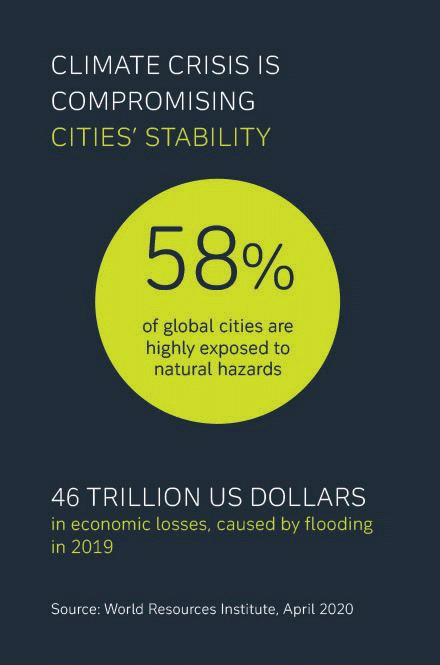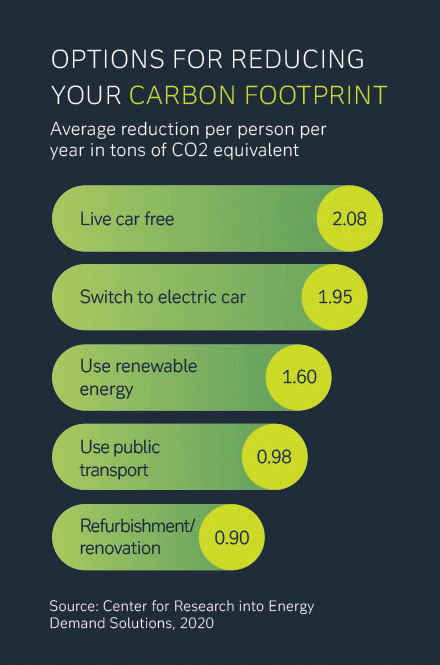
There’s no escaping cities
How can we combat climate change, save our earth, the species around us, and ourselves? Cities only recently have become recognised as hotspots of high risk / high impact to the climate crisis – and as important actors in solving it.
At the recent climate change conference in Glasgow the C40 Cities network – an alliance of mayors of nearly 100 world-leading cities – hosted an onsite and virtual exhibition showcasing climate action success stories in global cities. They made it very clear that “the path to a green, just, and prosperous future starts with action and investment in the world’s cities.”
Climate change is most felt in cities
 Today, cities are amongst the places most likely to feel the acute impacts of climate change. The masses of concrete, metal and glass in urban areas can make them warmer than the surrounding landscape due to the way they absorb, emit and reflect heat. Water shortages and worsening air pollution threaten to make life in many cities unbearable.
Today, cities are amongst the places most likely to feel the acute impacts of climate change. The masses of concrete, metal and glass in urban areas can make them warmer than the surrounding landscape due to the way they absorb, emit and reflect heat. Water shortages and worsening air pollution threaten to make life in many cities unbearable.
Research and statistics are clear: the climate crisis makes more than half of the world’s big cities (58 percent) vulnerable to at least one of biggest natural disasters, with flooding, storms and droughts leading the list. The key question, as our colleague and climate change expert Markus Müller asks, is whether many cities will still be habitable in the future.
The numbers show, how big the problem is: 680 million people are estimated to reside in low lying coastal areas, with this figure expected to rise to over one billion by 2050. It is projected that if global mean sea levels rise by 2 meters by 2100, up to 187 million people will be forced to relocate. Additionally, floods and rising sea levels are expected to cost the world's economy 14.2 trillion US dollars by the end of the century.
Cities are the driving forces of modern life – and major issuers of CO2
Cities generated 70 trillion US dollars in 2019 alone, which is 80 percent of global GDP; but this economic power has a downside and goes hand in hand with massive greenhouse gas emissions. The biggest drivers are energy consumption from households, services and industry, the built environment and mobility.
So, how can we bring emissions down in cities? And how can we plan cities for the future? There have long been numerous examples of this, such as the forest cities in China and Malaysia, or Masdar City in the United Arab Emirates, which wants to become the most sustainable city in the world.
Near Beijing, a city is being built entirely of timber. And when coastal cities start to sink, people might to move to floating cities. Such concepts are being worked on in many places. The Philippines is officially building a replacement for its capital because Manila is likely to be submerged. The new city will be located 100 kilometres from the coast and will be well prepared for earthquakes and other natural disasters.
Forewarned is forearmed
Are these newly built model cities - very often planned and constructed by renowned architect firms - the solution to global cities’ problems? If we look at the costs for a lot of these projects, it is unlikely that building entirely new cities from scratch can be the solution for an urban population that counts several billion people. But these projects are great experiments and might help evaluate the scenarios for which these different solutions could be adaptable.
Solutions for grown cities?
In our current dossier, we look at “grown” cities: what can effective responses to the climate crisis look like?
We asked Alan Organschi, architect and Director of the Bauhaus Earth innovation lab and a pioneer and campaigner for constructing timber cities, who makes it very clear that the most sustainable solution for major cities in Europe is not in building new, but in enthusiastically upgrading the existing stock - wherever possible.
From Madrid …
This way of thinking is very close to the agenda of Madrid’s municipality. The Spanish capital is part of the C40 network and wants to become climate neutral by 2050. In its sustainability strategy, the residential, commercial and institutional building sector is identified as being by far the biggest greenhouse gas issuer, contributing more than 50 percent of all emissions.
In our feature story, we highlight how that city is putting great effort in restoring its old buildings while also improving the living conditions of socially disadvantaged communities like the Barrio del aeropuerto. For our colleague Alvaro Pino from Deutsche Bank in Spain the important change that can be made for the daily life of the residents makes him feel proud.
… to Barranquilla

In Colombia, yet another aspect plays a role: biodiversity. After Brazil, Colombia is the country with the greatest diversity of species in the world. President Iván Duque-Márquez has put biodiversity conservation on the political agenda and launched the "BiodiverCities by 2030" initiative. The project wants to showcase how urban development and nature can be brought into harmony, and how nature-based solutions can make cities more liveable and resilient in dealing with the climate crisis.
In our story about Barranquilla, Colombia's most important port city on the Caribbean coast, you will learn how the commercial and industrial city is restoring the Mangrove forests as part of an ambitious development plan and how the population contributes to the city’s sustainability strategy.
No one-size-fits-all solution
It is clear from dealing with cities and the climate crisis that there is no one-size-fits-all solution. Geographical location, the importance of the city for the region, the building fabric, the economic priorities and many other factors have to be taken into account to evaluate the measures that quickly achieve the greatest impact. And these projects need to be financed.
Huge need for financing
In our expert interview, Claire Coustar from the investment bank explains how new cooperation with the private sector is key when it comes to financing. She sees green bonds as a “good instrument for cities to finance sustainable projects”.
Tech innovations for green cities?
Technology will also play a major role, and the private sector will be key in finding innovative solutions to the problem of cities. An interesting example of how new technology can bring emissions down is currently being tested by the company [ui!] in the city of Bad Hersfeld in Germany. Have you always wanted your own streetlight to turn on and off? Then take a look at our latest client video.

Sonja Dammann
… grew up in Twistringen, Lower Saxony, Germany. This is one of the reasons why she finds big cities so attractive. It's never boring and something crazy and unexpected is already around the corner! Since cities are places in which creativity, science and entrepreneurship easily come together, she is confident that good ideas for combating the climate crisis will emerge here in particular.
Recommended content
Responsible Growth | Opinion
“Cities are key players in lowering carbon emissions” “Cities are key players in lowering carbon emissions”
Transforming cities requires multiple efforts. Claire Coustar speaks about the role of financial markets and what Deutsche Bank is doing.
Responsible Growth | Photo Story
Mangroves and Metropolis Barranquilla: Mangroves and Metropolis
The port and industrial city of Barranquilla is to become Colombia's first BiodiverCity. About a metropolis seeking its path to a sustainable future.
Responsible Growth | Video Story
The power of sustainability in the palm of your hands Smart lighting for the city of the future
Imagine controlling your city’s street lighting from an app on your smartphone. The people of Bad Hersfeld are getting that opportunity.






